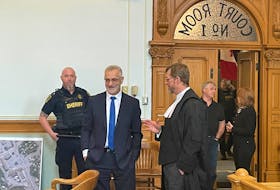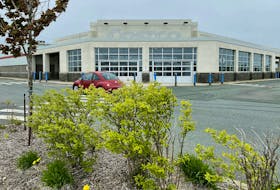To those who spent the past months dedicated to organizing events to mark the 100th anniversary of the SS Florizel disaster, an unexpected and deep connection was made to that time and to the people who perished, survived and attempted rescue.
It’s as if a century turned back in a blink.
Untold stories uncovered, forgotten artifacts revealed, and relatives and descendants of those connected with the tragedy have come forward from the local area, as well as from other provinces and the United States, to share information.
There have been books written about the tragedy in the past, but events at Mount Pearl and Renews-Cappahayden this weekend attempt to view the disaster through the eyes of those who lived it.
The Admiralty House Communications Museum in Mount Pearl — the site of the former HM Wireless building in 1918 that received the distress call from the Florizel — already has a permanent display on the tragedy. To mark the 100th anniversary, a special exhibit called “Faces of the Florizel” will open to the public in the museum’s annex building on Saturday and run to June 9.
“This exhibit will pay particular attention to these people,” museum manager Sarah Wade said. “It will tell what happened to them on the journey. Who were these people? Where were they going? Where were they from? And what kind of impact did this disaster have on their lives?”
A number of new artifacts will be part of the exhibit, including a chair that had been sitting in a local person’s attic for 50 years, and a porthole.
The Florizel left St. John’s harbour on Feb. 23, 1918 on what was a routine trip for the passenger liner, though in questionable weather. The vessel was to stop in Halifax to unload freight and passengers, then continue on to New York.
About 5 a.m. on Feb. 24, 1918 in blizzard conditions, the Florizel ran full steam into the rocks at Horn Head Point near Cappahayden. During the horrifying hours that followed, 138 people onboard fought for their lives while the ship was battered against the rocks, death near with each bag and boom, and each terrifying sound of the bending and scraping of steel against rock. As they tried to make their way to safer parts of the ship, ice-cold, roaring waves crashed over the decks and swept many away. Ninety-four people perished.
On the shore, residents anxious to attempt a rescue waited helplessly by lit fires for conditions to improve.
Susan Sheehan, clerk with the Town of Renews-Cappahayden, filed an application in 2016 to the federal Department of Canadian Heritage for funding to help the community commemorate the 100th anniversary of the Florizel tragedy. The funds were approved in June last year. Sheehan sent out notices for volunteers to help organize an event.
“We got $8,800 and for us and our small town that was, ‘Wow,’” Sheehan said. “In August 2017 we held our first meeting and I heard stories then that I didn’t know existed. It became apparent the project had to get bigger and we decided to construct a viewing site and put together an event and an exhibit.
“I just became so captivated with the history. I’m originally from Cappahayden and grew up in the area, and we always knew the story of the Florizel, but we didn’t know the full story. Through learning that, it became increasingly important for our residents and descendants of rescuers to mark the anniversary. Some of them risked their lives to rescue people from the Florizel. They saw a lot of horrific things. And a lot of them were responsible for getting those bodies brought to the train station.
“The classic books written didn’t portray the residents who went to help in a good light. That’s not how it happened.
“So Saturday will be a day that we want to commemorate and pay tribute to those who lost their lives, but to also celebrate the survivors and the heroism that took place here.”
Cassie Brown’s 1976 book “A Winter’s Tale” is probably the best-known account of the Florizel tragedy. Brown’s research for her book is held in the archives and special collections at Queen Elizabeth II Library at Memorial University.
Wade and museum assistant manager Deanna Walter said they have used information and items from the Cassie Brown collection for the exhibit, but what has excited them the most is the amount of new information, stories and images they were able to obtain through their own social media campaign, and through word of mouth.
Their primary goal was to connect with relatives of those who died, the survivors and those involved in the rescue or salvage efforts, and to get full names and birth dates, and their stories.
“Often people I talked to thought the information they had wasn’t important, but it was,” Walter said. “When you start talking to people they start remembering other things. We needed a name and how they are related to that person, and all of a sudden you have an anecdote or where they worked or what they were doing.”
Wade said the effort on social media paid off more than they could have imagined.
“Each week people would comment and tag others who have the same last names and gradually people were calling us and dropping off pictures of people,” Wade said. “And they are great images, and we’d try to get as much information about that individual as we could.”
Walter notes one story that stands out to her and Wade.
She said in Brown’s book, there’s little on a man known only as C.H. Miller. With new information coming forward from friends and relatives of the Miller family, they were able to fill in the story.
“His name is Charles Miller and he was a passenger. In 1912 his wife died and he had two young boys to support,” Walter said. “He was very prominent in the Jewish community and helped to establish the first synagogue in St. John’s. In late 1917 distant relatives were visiting from New York and he fell in love with a distant cousin, and so they were going to New York to be married.
“His sister, Minnie, however, told him it wasn’t a good idea to travel on the same ship as his future wife, even though she would be chaperoned by her other relatives.
“So he booked his ticket for the next sailing to New York, which was on the Florizel that left on Feb. 23, 1918, and he did not survive the disaster. One of his sons, Bernard, moved to the United States. The other, Leonard, became an influential doctor and political figure in the province. The Dr. Leonard A. Miller Centre is named after him.”
Walter relates another story that will appear in the exhibit.
When local Tom Kane was heading to the site of the Florizel wreck to help out, an older man from the area who was poor asked him if he could bring back any clothing that was around. Kane found some clothes at the wreck site and brought them back to the man. Sometime later, the old man told Kane that he had found $45 inside one of the pockets. He didn’t keep it for himself, but gave it to the priest.
Kane asked him why he would do such a thing, telling the old man he should have kept it for himself because he was so poor. The old man said he wouldn’t be able to sleep if he kept it.
Sometime later, the old man died from hunger.
At the new viewing site in Cappahayden on Saturday, provincial and federal dignitaries and relatives of those who perished, as well as relatives of survivors and descendants of rescuers, will take part in a wreath-laying ceremony at noon. At 1 p.m. at the town hall, there will be storytelling, songs of the sea and food, as well as an exhibit of Florizel artifacts and information.
The key artifact on display will be a door believed to be from the Florizel. The door had been used in a cabin in the area for more than 50 years.
At the Admiralty House Communications Museum there’s been a buzz of activity all week as the exhibit was being set up.
“I’m extremely proud of the work we’ve done,” Wade said. “When we are putting out information and stories, we are extremely vigilant of what stories we are sharing. What is the historical significance? Where did we get this information? And what is the angle we take on these stories?
Wade noted that the exhibit space has been set up to make it seem like the visitor is going through the experience with a passenger.
“They don’t find out right on the first panel if the passenger survived or died, but follows the journey,” Wade said. “The last panel will tell who survived and who perished. And to connect people more, Deanne came up with an idea to have boarding passes with names on it. So you are getting on this voyage as a passenger and you can follow that passenger’s story. It’s an attempt to put yourself in the shoes of someone on the Florizel.
“It’s a sad story, but it is a very interesting one to tell. It doesn’t matter the time, or how long ago it happened, you are still connected to these stories.”
Through the exhibits it is hoped the voices of those who perished, those who survived and those who attempted a rescue on that stormy, cold and horrifying early morning of Feb. 24, 1918 — and the locals who later had the grim task of gathering bodies from the wind-whipped shoreline and beaten ship’s hull — can be heard again.
“These stories are 100 years old, but at the same time their thoughts and feelings and hopes and dreams, and their lives are still similar to what we go through on a daily basis,” Walter said. “I think we can all relate to at least one person’s story when we go through the exhibit.”








